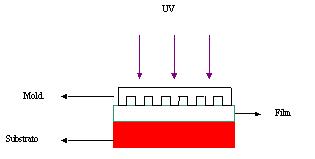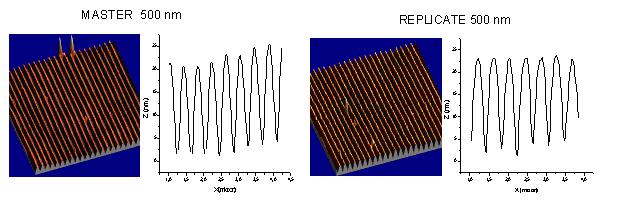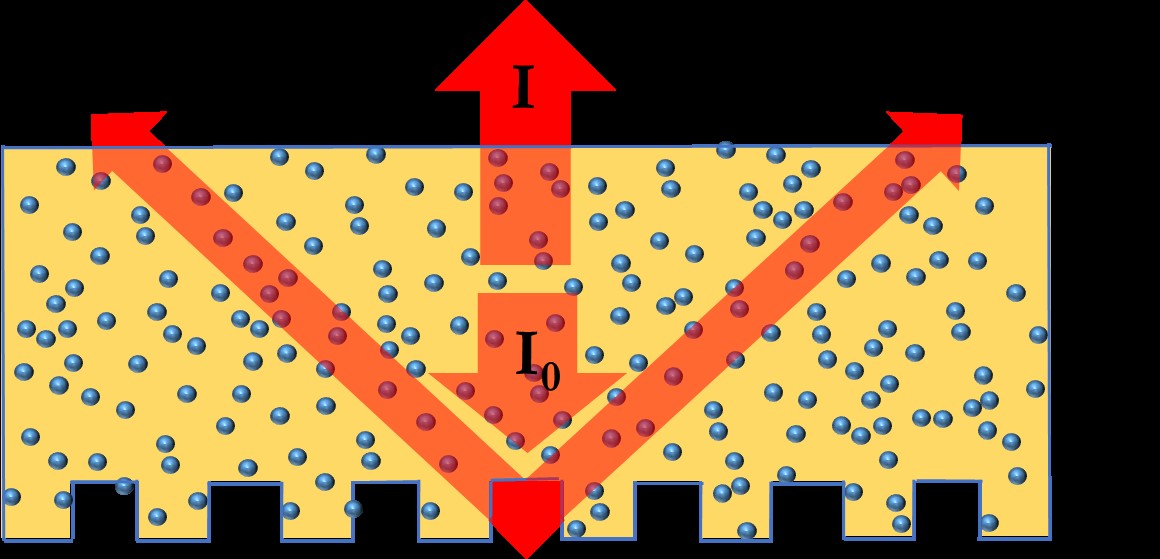Light Management
We are able to produce nanostructures of planar surfaces in order to increase the interaction of the light with specific layers. The patterns (Bragg gratings and two dimensional structures) are produced by direct laser interference on photopolimerizable materials or by the use of soft lithography (SL) methods. The main application is in the enhancing of the harvesting of the light in solar cells in order to get higher power conversion efficiency (PCE).
SOFT LITHOGRAPHY
A technique belonging to the suite of SoftLithography, namely nanoimprinting, has been investigated by our group in order to produce Bragg grating filters. These kind of devices are employed either as optical coupler and telecommunications filters (for the third optical window at 1500nm). Hybrid solgel titanium based
films (Ti/TMSPM) doped with a photosensitive agent have been employed for this aim. A Bragg grating is originally produced on this film by direct writing method based on
the interference generated by Lloyd mirror using the UV-line @364 nm of an Ar laser. Samples then undergo a development step with isopropyl alcohol and a densification
@160°C.Grating periods ranging from 2 mm down to 500 nm have been realized by selecting different angles of incidence on the mirror.
These kind of devices are employed either as optical coupler and telecommunications filters (for the third optical window at 1500nm). Hybrid solgel titanium based
films (Ti/TMSPM) doped with a photosensitive agent have been employed for this aim. A Bragg grating is originally produced on this film by direct writing method based on
the interference generated by Lloyd mirror using the UV-line @364 nm of an Ar laser. Samples then undergo a development step with isopropyl alcohol and a densification
@160°C.Grating periods ranging from 2 mm down to 500 nm have been realized by selecting different angles of incidence on the mirror.
 From this master it has been
obtained a PDMS mold from which several replica have been produced by means of UV-nanoimprinting.
From this master it has been
obtained a PDMS mold from which several replica have been produced by means of UV-nanoimprinting.
Either molds and replica have been characterized by means of AFM measurements. The following pictures show AFM results for a master whose grating periods is 500nm and its final replica on hybrid material.
The nanostructuring of the active layer of a DSC by means of low-cost Soft-Lithography technique brings a consistent increase of the cell
efficiency. We fabricated Bragg gratings on a high performance photoresist by means of Laser Interference Lithography
obtaining structures whose dimensions are approximately 200 nm height and 500 nm pitch.
 We replicated the structures on a PDMS mold and used it to directly imprint a DSC titania layer by UV imprinting.
Morphological characterization of the samples by means of AFM and SEM measurements showed the presence of good quality
periodic structures on the titania layer over a large area.
We replicated the structures on a PDMS mold and used it to directly imprint a DSC titania layer by UV imprinting.
Morphological characterization of the samples by means of AFM and SEM measurements showed the presence of good quality
periodic structures on the titania layer over a large area.
Nanostructured and standard DSCs have been fabricated under exactly the same experimental conditions in
order to compare their photovoltaic response. A 31% increment of the efficiency for the nanostructured cells has been estimated
by photovoltaic measurements. This result validates our previous theoretical calculations. The present work suggests
that a cost effective and simple light management strategy based on soft lithographic method can be applied for DSCs
efficiency improvement.
References
- L. D'Amico, D. Colonna, R. De Angelis, M. Casalboni, F. De Matteis, A. Di Carlo, P. Prosposito
Bragg gratings nanostructuring of TiO2 layer in dye sensitized solar cells: an efficient method to enhance light harvesting
RSC Advances , 4(83), 43828-43833 (2014).
- D. Barettin, A. Di Carlo, R. De Angelis, M. Casalboni, P. Prosposito,
Effect of dielectric Bragg grating nanostructuring on dye sensitized solar cells
Opt. Expr. ,20 S6 A888 (2012).